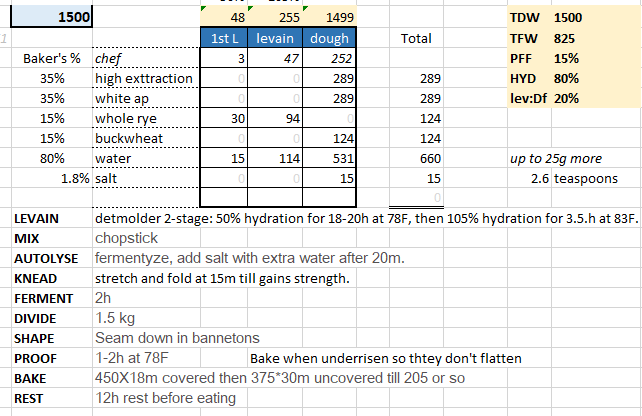Loaf - White (Pullman) Recipe card from metricsbaking spreadsheet

- Log in or register to post comments
- View post
- Rafe's Blog


Looking to expand my repertoire with something less loafy, so thought I'd give English Muffins a go again after THIS ATTEMPT about 12 years ago! :) I'm much happier with the results on these, which I will humbly chalk up to my gaining a bit of dough handling and reading experience in the intervening years! :)

I've been wanting to try Dave Snyder's San Joaquin formula, and I've also been wanting to try my hand at making a Pain Rustique loaf a la Prof. Calvert. So I combined the two, and it worked great.
Here's the formula, which I think has been updated a few times, with this maybe being the most recent -
https://www.thefreshloaf.com/node/53813/san-joaquin-sourdough-two-ways

Today's bake: Taralli Pugliesi - Italy
Source: insidetherustickitchen.com - Emily Kemp
Note: Modified the mix times to utilize a processor (FP).
Substitutions: AP flour for 00


Spontaneous fermentation of water soaked raisins (sultanas). 3rd life cycle (refresh) [pic]
Kept @ 27°C for 3 weeks (once a week remake with water and fruit + previous ferment top-up)
Then used to seed a flour and water dough at a concurrent 27°C, kept in a volume of water.
7 days and 7 refreshes @ 1:1 or thereabouts daily (24hrs).
Next 8hrs, then 4hrs x3.
Typical float time = ~45 mins in all cases.
Looking good for a viable vigorous starter.
The last of my einkorn flour was used to make this loaf. Einkorn hasn’t been easy to find, one of the places I used to go to for interesting flours has changed hands and the new owners are not selling as many varieties of flour anymore. Since einkorn is a very weak flour I use it in the tangzhong since in its preparation the proteins are denatured so any gluten potentially from the einkorn won’t contribute to the gluten structure of the final bread.

Cherry season is going strong and they are readily available for a good price at the supermarket so I figured it was a good time to bake another version.
I had some leftover grits from a recent brunch so that was added for some extra texture and flavor. These had some cheese and butter added and added quite a bit of extra hydration along with the fresh cherries to the dough. The cherries were pitted and cut into pieces and drained in some paper towels before adding.

Today's bake: Muscovite Rye/Podmoskovny Rye (Russia)
Source: theryebaker.com/muscovite-rye/ by Stanley Ginsberg
Note:

Hamelman's mixed grain miche from Bread 3rd ed. It's 15% buckwheat and 15% rye (the starter). A winner!
Formula


I’ve made bread with rice several times before and always love the added flavor and texture it brings to the party. I used a purple (more black) rice I made with some onion stock which was very tasty.
The flours I used were freshly grounded whole wheat (Rouge de Bordeaux ) and Rye from Barton Spring Mill) sifted twice and milled twice as well as some KAF bread flour.
The overall hydration is higher than indicated in the formula since the rice added some extra moisture. The dough was pretty wet but was manageable.